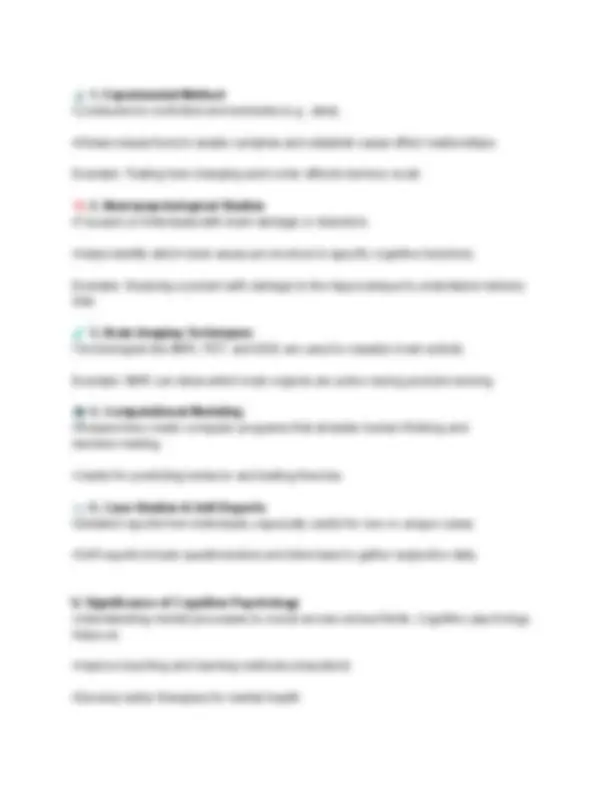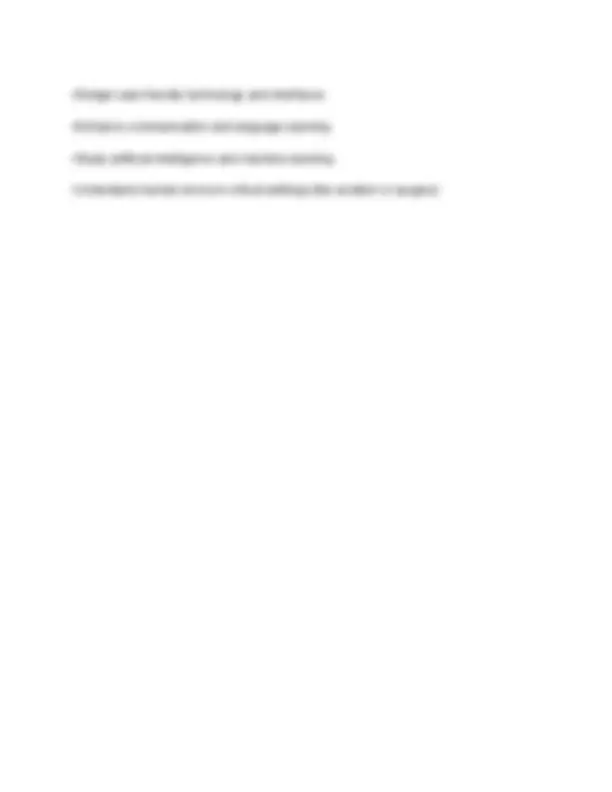




Study with the several resources on Docsity

Earn points by helping other students or get them with a premium plan


Prepare for your exams
Study with the several resources on Docsity

Earn points to download
Earn points by helping other students or get them with a premium plan
Community
Ask the community for help and clear up your study doubts
Discover the best universities in your country according to Docsity users
Free resources
Download our free guides on studying techniques, anxiety management strategies, and thesis advice from Docsity tutors
To examine the historical development, major theoretical approaches, and research methods in cognitive psychology in order to understand how mental processes such as memory, attention, language, and problem-solving are scientifically studied and applied in real-world contexts.
Typology: Lecture notes
1 / 4

This page cannot be seen from the preview
Don't miss anything!



I. History of Cognitive Psychology Cognitive psychology emerged as a response to the limitations of behaviorism, which dominated psychology in the early 20th century. While behaviorism focused on observable behaviors and external stimuli, cognitive psychology emphasized mental processes like thinking, memory, and language.
🔹 Early Influences: Wilhelm Wundt: Considered the father of psychology. Used introspection to explore the content of consciousness. He believed mental processes could be studied scientifically.
Hermann Ebbinghaus: Pioneered experimental research on memory. He introduced the "forgetting curve" and studied how we retain or lose information over time.
Frederic Bartlett: Criticized artificial memory experiments and emphasized the role of schemas—mental structures that shape how we interpret and remember information.
Jean Piaget: Known for his theory of cognitive development in children. He proposed stages (sensorimotor, preoperational, etc.) through which thinking evolves as a child matures.
Noam Chomsky: Challenged B.F. Skinner's behaviorist view of language. He argued that humans have an innate language acquisition device, which reintroduced mental processes into psychology.
Ulric Neisser: Often called the “father of cognitive psychology.” He published the first textbook titled Cognitive Psychology in 1967, defining the field’s scope.
II. The Cognitive Revolution (1950s–1960s) This revolution marked a shift from behaviorism to a renewed interest in the mind. Psychologists began comparing the human mind to a computer, introducing models based on input–process–output systems.
Key characteristics of this revolution:
•Rise of information processing theory
•Emphasis on internal mental operations
•Focus on areas such as attention, memory, perception, language, and decision-making
III. Major Approaches in Cognitive Psychology
1. Information-Processing Approach •Compares the human mind to a computer system.
Mental processes are seen as a sequence of steps (like a flowchart): ➤ Input (stimulus) → Processing (thinking, memory) → Output (response)
Example: In reading, your eyes see the words (input), your brain processes their meaning, then you speak or comprehend the content (output).
2. Connectionist Approach (also called PDP or neural networks) •Inspired by the structure of the brain.
•Mental processing occurs in parallel, not in a step-by-step sequence.
•Involves interconnected units (like neurons) that activate together.
Example: When seeing a dog, you simultaneously recall its name, experiences, and emotions—this happens all at once, not in order.
•Emphasizes studying cognition in real-world contexts, not just in artificial lab settings.
•Believes understanding is better when people are observed in their natural environments.
IV. Methods Used in Cognitive Psychology Cognitive psychology uses a range of methods to investigate how we think, remember, and perceive:
•Design user-friendly technology and interfaces
•Enhance communication and language learning
•Study artificial intelligence and machine learning
•Understand human errors in critical settings (like aviation or surgery)